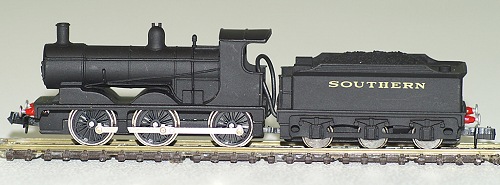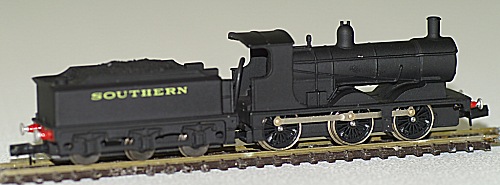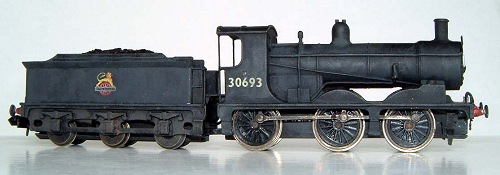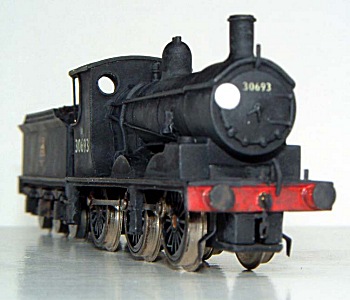Union Mills's Drummond 700 class 0-6-0 locomotive
| Union Mills is a small one-man 'cottage industry'. Being
a small company enables it not only to keep a close eye on production quality
but also allows them to produce models that would otherwise be overlooked by
the larger companies. Proprietor Colin Heard has a proven track record which
started when he worked for Peco in the early 1970s through to forming Cooper
Craft models in 1978. This he sold in 1991 and on moving to the Isle of Man
started production in 1994 of a small number of RTR N gauge models. The latest
for the delight of Southern N gauge modellers is a Drummond 700 class
0-6-0.
Union Mills has modelled the superheated version which is correct from December 1920 (316 the first to be converted), lasting to the end in 1963/4. Liveries available to date are either SR or BR(S) black, whilst the loco can also be ordered un-numbered. |

photographs by Mike Boydon |
 |
| As is standard on all Union Mills models to date the model is
tender driven, and haulage capacity is superb - they will pull 80+ wagons and
run well at low speeds. Construction is with a heavy metal body, traction tyres
on one side of tender drive and the pickup via axles (one side of tender, other
side of loco). It is also pleasing to see the lack of skirt under the boiler,
so common on many N gauge steam outline models, which is possibly due to the
tender drive.
There are a few compromises on the dimensions when compared against a 4mm Skinley drawing. The main issue is that the height is too great by 1.5 - 2 mm. This is probably because the tender had to be increased to fit the motor, and the loco has been correspondingly increased in proportion. It doesn't look bad on its own but can look too tall next to other models. For example, the cab roof is noticeably higher than that of coaches or of other similar locos. The width is also oversize by around 0.5mm, which is also reflected in the cab/splasher width. Footplate length scales to a near correct 26' 5". The wheel spacings and diameter are correct, and with the correct number of spokes. The connecting rods are a little on the heavy side and as advised below can be improved by filing down. Tender wheels are too slightly too small (3 ft not 4 ft) and are not spoked. The small size is disguised by the centres being a scale 6" too low, so the bottoms of the wheels are in the correct place. Like all UM models the overall detail is OK but rather basic. What is there is well moulded, e.g. various pipes and handrails. The coal load is also moulded and would benefit from some real coal being glued in place. Some of the painting could be improved, e.g. the silver buffer heads. Some items missing include brake gear, reversing rod and vacuum pipes. There are a number of simple of improvements that can be made:
|
 |

|
| Conclusion; a very welcome addition to N gauge stock so long
overdue, a few minor niggles, but when compared with offerings from
Bachmann/Farish these can almost be ignored. When compared with the Dapol M7
(the only other Ex LSWR loco available RTR) it does suffer a bit; Dapol have
modelled brake gear and their handrails are separate, not moulded.
Review by Graham R Muspratt, Mike Boydon and Noel Leaver |
All photographs are copyright
return to model railway product review index
This page was created 22 September 2007